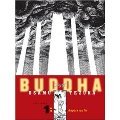







I do not claim to know anything about Buddhism, graphic novels or, for that matter, formatting photos in Blogger (my apologies for the above arrangement), but that did not keep me from pushing through all eight volumes of Osamu Tezuka's imaginative and epic retelling of the life of Siddhartha. And I do mean epic: ranging across the foothills of the Himalayas thousands of years ago, Buddha has a huge cast of characters and enough raging battles, miracles and doomed love affairs to make any Charleton Heston flick pale in comparison. This isn't an accident; Tezuka takes definite liberties with the historical record, creating characters and events that help to define his vision of Siddhartha's journey to enlightenment, with a great deal of pulpy action and adventure thrown in. The result is a mostly fast-paced, sometimes irreverent romp through ancient northern India, as Siddhartha slowly becomes Buddha and develops his insights that would become the religion of Buddhism.
Handsomely published in the U.S. by Vertical, the real star of Buddha isn't the story, but Tezuka's vibrant artwork. Best known for his Astro Boy series, Tezuka's take on Buddha is sort of manga for adults--but with all the same visual appeal as his more popular work. The settings allow for some beautiful and suprisingly detailed panoramas, and the violence is simply but effectively portrayed in a spray of ink. Probably the most effective aspect as I read along was Tezuka's ability to depict the emotions of his characters: a devious look instantly establishes a character's untrustworthy nature, and the full impact of Siddharta's inner struggle is telegraphed over his features.
That the visual is so well done works well in Tezuka's favor, as the weakest point about Buddha is the sometimes painful dialog. Do not expect great monologues to complement the great art. But the dialog does have the benefit of making each volume a pretty fast read (each averaging around 350 pages, a volume can be finished off, at most, in a few hours). Other quibbles: the height of the story, I felt, came in the middle of the set (v. 3-5), with the story tending to drop off a bit in the concluding installments. And given how much of Buddha is imagined, it was rather disappointing to see most female characters relegated to passive slaves or victimized royalty. As an introduction to the work of Tezuka, Buddha might not be representative, but it does mark an interesting blend of the serious with a popular art form gaining in respect.
.jpg)
No comments:
Post a Comment